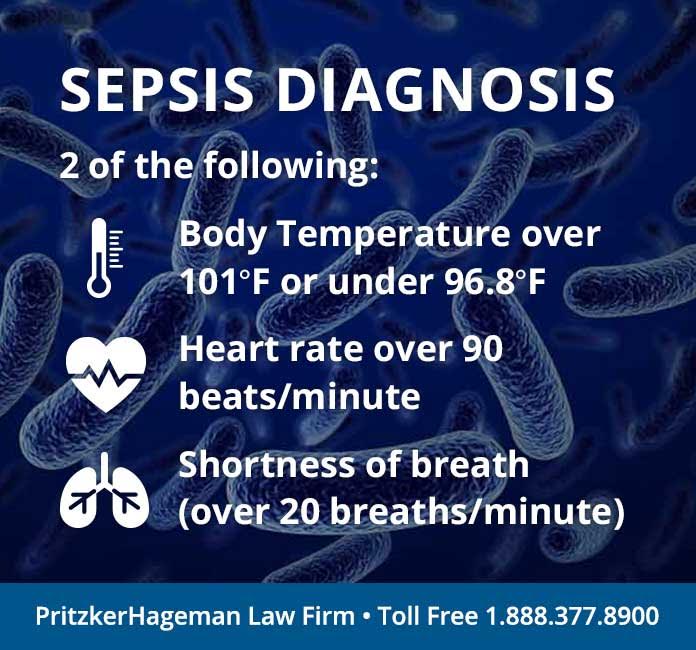Our lawyers have won millions for clients with cases involving sepsis, a severe complication of an infection. You can contact our law firm and talk with a lawyer about a sepsis lawsuit using the form below.
Any Infection Can Cause Sepsis
Infection can lead to sepsis, a life-threatening condition that can cause tissue damage, organ failure, and death. The patient or the family (if the patient does not survive) may be able to sue for compensation if a medical professional negligently failed to diagnose sepsis (medical malpractice) or if the initial infection was caused by one of the following:
- eating food contaminated with dangerous bacteria (Clostridium botulinum, Campylobacter, E. coli, Listeria, Salmonella, Shigella, Vibrio):
- Legionnaires’ disease, severe pneumonia caused by Legionella bacteria;
- contaminated medical device, IV, injection medication or other medical product;
- an injury suffered in an accident that was caused by the negligence of a person or company (car crash, etc.);
- a dog bite, and the animal was owned by a person or company.
Each of these are discussed in detail below. Our law firm has successfully handled all of these kinds of cases.
What is Sepsis?
When there is an infection, the body releases chemicals into the blood stream to fight it. Sepsis occurs when these chemicals trigger an inflammatory response. This can can affect any part of the body and can occur even after a minor infection. According to the CDC, over a million people in the U.S. get sepsis each year, and the motality rate is high, about 50 percent for patients who go into septic shock.
Severe sepsis lessens the blood flow to the brain, heart and kidneys, and other organs, which can cause organ failure and death. It can also cause blood clots to form in organs, which can also lead to organ failure and death. Blood clots can also form in an arm, leg, finger or toe. This can lead to gangrene and amputation.
What are the Signs and Symptoms?
Because sepsis is the result of an infection, signs and symptoms can include:
- infection signs (diarrhea, vomiting, sore throat, etc.);
- fever above 101 degrees F;
- body temperature below 96.8 degrees F;
- heart rate higher than 90 beats a minute;
- shortness of breath (respiratory rate over 20 breaths per minute);
- extreme pain or discomfort (“worst ever”);
- extreme fatigue;
- abrupt change in mental status that often results in extreme con
For it to be sepsis, there has to be a diagnosed infection in addition to other symptoms.
Complications
Severe sepsis lessens the blood flow to the brain, heart and kidneys, and other organs, which can cause organ failure and death. It can also cause blood clots to form in organs, which can also lead to organ failure and death. Blood clots can also form in an arm, leg, finger or toe. This can lead to gangrene and amputation.
What to Do if You Suspect Sepsis?
The CDC recommends the following if you think you or a loved one has this condition:
- Call your doctor or go to the emergency room immediately if you have any of the signs or symptoms discussed above. This is a medical emergency.
- It’s important that you say, “I AM CONCERNED ABOUT SEPSIS.”
- If you are continuing to feel worse or not getting better in the days after surgery, ask your doctor about sepsis, a common complication of people hospitalized for other reasons.
Food Poisoning

When food is contaminated with any of the following pathogens, the person who ate it can contract a life threatening infection:
.
Legionnaires’ Disease
Legionnaires” disease is a caused by breathing in water mist contaminated with Legionella bacteria. The pathogen travels to the lungs and causes pneumonia. To recover compensation for Legionnaires’ disease, the source of the infection has to be found. If a source is found, the amount of the settlement will be affected by the insurance coverage of those responsible, generally the owner of a building, and other financial considerations.
Contaminated Medical Product
If medical device products, such as endoscopes and dialysis equipment, are exposed to pathogens, they can transmit the pathogens to a patient. Similarly, if medication used in an IV bag or syringe is contaminated, the pathogens can infect a patient. For example, outbreaks of hospital-acquired carbapenem-resistant Enterobacteriaceae (CRE) infections around the country were associated with endoscopes used for endoscopic retrograde cholangiopancreatography (ERCP), called duodenoscopes. An outbreak of Serratia marcescens bacteremia was linked to liquid nutrition fed through an IV using a catheter.
Pathogens involved in these kinds of infections, include the following:
- Staphylococcus aureus;
- Methicillin resistant Staphylococcus aureus (MRSA);
- Candida albicans;
- Pseudomonas aeruginosa;
- Acinetobacter baumannii;
- Stenotrophomonas maltophilia;
- Clostridium difficile;
- Escherichia coli (E. coli);
- Vancomycin-resistant Enterococcus.
Auto Accident
If there is sufficient evidence that an infection is caused by an injury sustained in an auto accident, the injured person may have a personal injury claim against the at-fault driver and others. For example, if a commercial truck driver caused or contributed to the accident, the owner of the semi-tractor, trailer and freight being hauled may be legally responsible.
Dog Bite
Although not common, a penetrating dog bite can cause an infection, commonly from the bacteria Capnocytophaga canimorsus. If you were bitten by a dog, you may have a claim against the dog owner (compensation from homeowner’s insurance), and possibly others who, although not the owner, are still legally responsible attack. For instance, a daycare center might be liable if staff allowed someone with an aggressive dog onto the property, or a landlord might be liable if he or she knew that a tenant had a dangerous dog.
